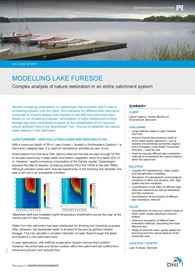Helping nature restoration in the Lake Fureso catchment system
In order to evaluate various lake restoration methods and their impacts on the Lake Fureso catchment system, we conducted comprehensive coupled three-dimensional (3D) hydrodynamic and eutrophication modelling.
 In order to evaluate various lake restoration methods and their impacts on the Lake Fureso catchment system, we conducted comprehensive coupled three-dimensional (3D) hydrodynamic and eutrophication modelling. Based on our analyses, we pinpointed the most effective lake restoration methods. This helped our client to meet the necessary water quality objectives (aligned to the European Union Water Framework Directive) and restore the natural balance of the catchment area.
In order to evaluate various lake restoration methods and their impacts on the Lake Fureso catchment system, we conducted comprehensive coupled three-dimensional (3D) hydrodynamic and eutrophication modelling. Based on our analyses, we pinpointed the most effective lake restoration methods. This helped our client to meet the necessary water quality objectives (aligned to the European Union Water Framework Directive) and restore the natural balance of the catchment area.
Lake Fureso – Denmark’s deepest lake – is used for recreational activities all year round. Rapidly increasing urbanisation of the Danish capital, Copenhagen, exposed the lake to steadily increasing pollution from the 1900s to the late 1960s. Although pollution loads were reduced significantly in the following two decades, the lake is still not in an acceptable condition.
Long-term pollution had caused heavy eutrophication in the lake. The ecosystem responded with:
- algal blooms
- anoxic conditions in the bottom water
- periodically extensive growth of certain species of fast growing macro vegetation
It became necessary to deal with these challenges and evaluate all possible lake restoration methods.
We undertook the project to establish the technical basis for decision of measures to ensure that the water quality objectives were fulfilled within the defined timescale. We calibrated and used a 3D Hydrodynamic, Water Quality and Eutrophication model to quantify the effects of different scenarios (with respect to load reduction, restoration and flow).
Based on our analyses, recirculation of highly treated and purified sewage has been considered to speed up the rehabilitation of the lake and ensure sufficient flow in the downstream river. This will help re-establish the natural water balance in the catchment.
Read more